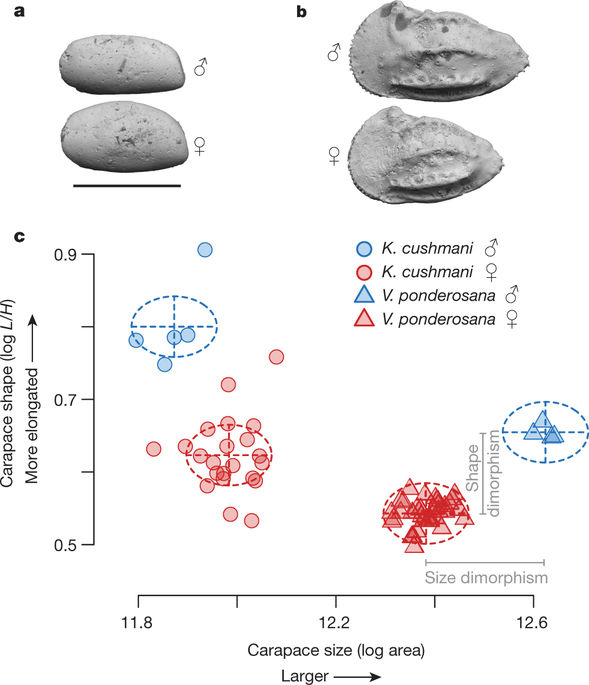Our official English website, www.x-mol.net, welcomes your
feedback! (Note: you will need to create a separate account there.)
High male sexual investment as a driver of extinction in fossil ostracods
Nature ( IF 50.5 ) Pub Date : 2018-04-01 , DOI: 10.1038/s41586-018-0020-7 Maria João Fernandes Martins , T. Markham Puckett , Rowan Lockwood , John P. Swaddle , Gene Hunt
Nature ( IF 50.5 ) Pub Date : 2018-04-01 , DOI: 10.1038/s41586-018-0020-7 Maria João Fernandes Martins , T. Markham Puckett , Rowan Lockwood , John P. Swaddle , Gene Hunt

|
Sexual selection favours traits that confer advantages in the competition for mates. In many cases, such traits are costly to produce and maintain, because the costs help to enforce the honesty of these signals and cues1. Some evolutionary models predict that sexual selection also produces costs at the population level, which could limit the ability of populations to adapt to changing conditions and thus increase the risk of extinction2–4. Other models, however, suggest that sexual selection should increase rates of adaptation and enhance the removal of deleterious mutations, thus protecting populations against extinction3, 5, 6. Resolving the conflict between these models is not only important for explaining the history of biodiversity, but also relevant to understanding the mechanisms of the current biodiversity crisis. Previous attempts to test the conflicting predictions produced by these models have been limited to extant species and have thus relied on indirect proxies for species extinction. Here we use the informative fossil record of cytheroid ostracods—small, bivalved crustaceans with sexually dimorphic carapaces—to test how sexual selection relates to actual species extinction. We show that species with more pronounced sexual dimorphism, indicating the highest levels of male investment in reproduction, had estimated extinction rates that were ten times higher than those of the species with the lowest investment. These results indicate that sexual selection can be a substantial risk factor for extinction.Ostracod species (small, bivalved crustaceans) with high sexual dimorphism, and therefore high male investment, had markedly higher extinction rates than low-investment species, indicating that sexual selection can be a substantial risk factor for extinction.
中文翻译:

高雄性性投资是化石介形虫灭绝的驱动因素
性选择有利于在配偶竞争中赋予优势的特征。在许多情况下,这些特征的产生和维护成本很高,因为这些成本有助于加强这些信号和线索的真实性1。一些进化模型预测,性选择也会在种群水平上产生成本,这可能会限制种群适应不断变化的条件的能力,从而增加灭绝的风险 2-4。然而,其他模型表明,性选择应该提高适应率并加强有害突变的去除,从而保护种群免于灭绝3、5、6。解决这些模型之间的冲突不仅对于解释生物多样性的历史很重要,而且也与了解当前生物多样性危机的机制有关。之前测试这些模型产生的相互矛盾的预测的尝试仅限于现存物种,因此依赖于物种灭绝的间接代理。在这里,我们使用 cytheroid ostracods(具有两性异形甲壳的小型双壳甲壳类动物)的信息丰富的化石记录来测试性选择与实际物种灭绝之间的关系。我们表明,性别二态性更明显的物种,表明雄性生殖投资水平最高,估计灭绝率是投资最低的物种的十倍。这些结果表明,性选择可能是灭绝的重要风险因素。 介形纲动物(小型双壳甲壳类动物)具有高度的性别二态性,因此雄性投资较高,
更新日期:2018-04-01
中文翻译:

高雄性性投资是化石介形虫灭绝的驱动因素
性选择有利于在配偶竞争中赋予优势的特征。在许多情况下,这些特征的产生和维护成本很高,因为这些成本有助于加强这些信号和线索的真实性1。一些进化模型预测,性选择也会在种群水平上产生成本,这可能会限制种群适应不断变化的条件的能力,从而增加灭绝的风险 2-4。然而,其他模型表明,性选择应该提高适应率并加强有害突变的去除,从而保护种群免于灭绝3、5、6。解决这些模型之间的冲突不仅对于解释生物多样性的历史很重要,而且也与了解当前生物多样性危机的机制有关。之前测试这些模型产生的相互矛盾的预测的尝试仅限于现存物种,因此依赖于物种灭绝的间接代理。在这里,我们使用 cytheroid ostracods(具有两性异形甲壳的小型双壳甲壳类动物)的信息丰富的化石记录来测试性选择与实际物种灭绝之间的关系。我们表明,性别二态性更明显的物种,表明雄性生殖投资水平最高,估计灭绝率是投资最低的物种的十倍。这些结果表明,性选择可能是灭绝的重要风险因素。 介形纲动物(小型双壳甲壳类动物)具有高度的性别二态性,因此雄性投资较高,











































 京公网安备 11010802027423号
京公网安备 11010802027423号